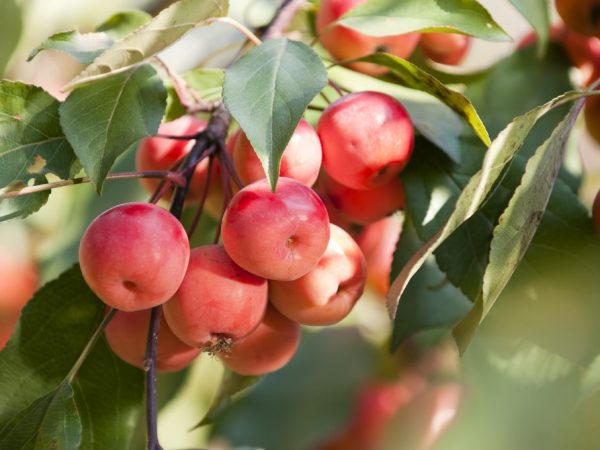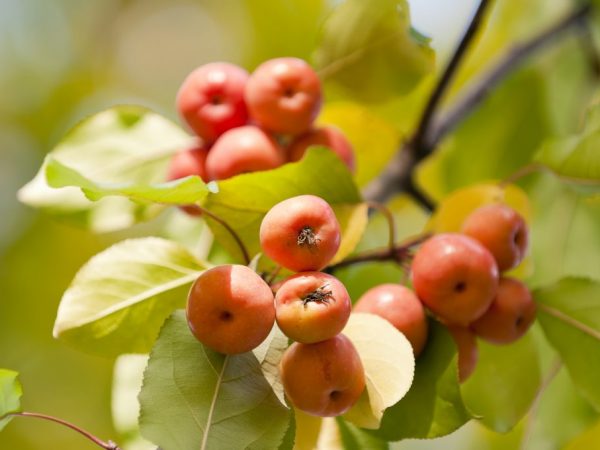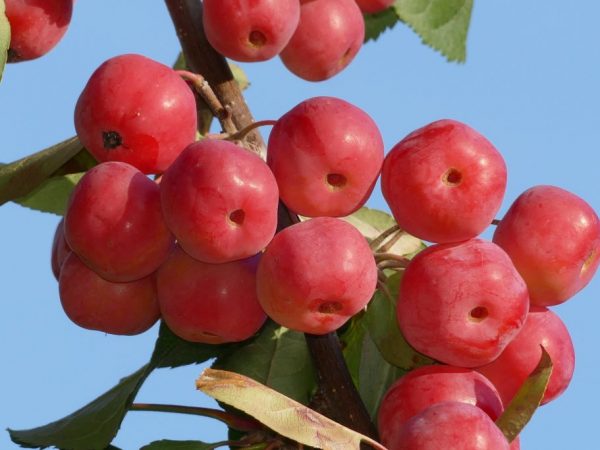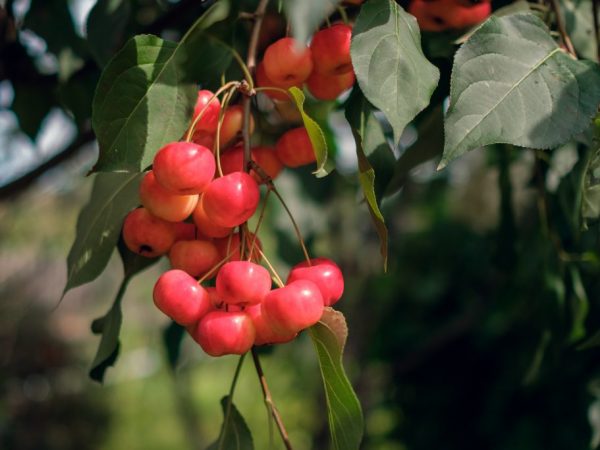Growing an apple tree Berry
The Yagodnaya apple tree is a unique genus of ornamental trees that originates in Northern China and Siberia. The culture is very popular with gardeners due to the picturesque appearance at the time of flowering, environmental significance and, of course, unpretentious care.
- Characteristics of the variety
- Advantages and disadvantages
- Description of the tree and fruit
- Yield
- Pollinating varieties
- Taste
- Winter hardiness
- Disease and pest resistance
- Landing
- Timing
- Technology
- Care
- Watering
- Pruning and shaping the crown
- Graft
- Features of ripening and fruiting
- Harvesting and storage
- Varieties
- Application
- In landscape design
- For medical purposes

Growing an apple tree Berry
Characteristics of the variety
The tree is widely used in landscape design, due to the long flowering and appearance of the fruits, similar in shape, size and color to berry crops. At the moment, it has taken root in almost all corners of Europe.
Advantages and disadvantages
The main disadvantage of the apple tree is the tart and bitter-tasting fruits. They are inedible and are rather aesthetic value for people. Another negative characteristic is the tendency to spread fungal infections among other trees, which causes considerable trouble for gardeners.
Nevertheless, a number of positive properties overshadow all the disadvantages of this variety.
Among the main advantages of the apple tree stand out:
- it performs a decorative function;
- winter hardy;
- high yield;
- it tolerates drought easily;
- valuable wood;
- resistance to pests.
Description of the tree and fruit
The berry apple tree is large (up to 9 m high), less often there are subspecies resembling shrubs (3 m). The trunk is twisted, broken. The wide rounded crown during the flowering period is abundantly covered with small white (sometimes pink) odorless flowers.
Small fruits are light and reach no more than 2 cm in diameter. The color is very varied: it ranges from light orange to deep red. The apples are held on a long stalk. Their low weight contributes to the long stay of the crop on the branches.
Elongated dark green leaves. They, unlike fruits, do not stay on the branches for long. With the arrival of early autumn, the leaves turn red and fall off quickly. The fruits contain a large amount of nutrients.
Yield
The tree is abundant and bears fruit every year, reaching 5 years. Apples ripen by autumn and remain on the branches until mid-winter.
Pollinating varieties
According to the description of the Yagodnaya apple tree, it is self-fertile, i.e. unable to bear fruit in single-sorted plantings. Flowering occurs in May, so varieties with a similar growing season are suitable for pollination.
Sibiryachka is often used in world selection and is considered one of the best rootstocks in fruit growing. With its help, cold-resistant industrial species are derived. She is also an excellent pollinator.
Taste

Fresh apples cannot be consumed
The fruits are not known for their pleasant taste and are considered inedible when fresh. They are tart and sour. They are used to prepare wine and apple cider vinegar, marmalade and marshmallow.There is an opinion that the jam from these apples is delicious.
Winter hardiness
The tree has a unique ability to withstand severe frosts down to -58 ° C. This allows the fruit to remain on the branches for a long time, and the flowers to be resistant to sudden changes in temperature.
Disease and pest resistance
The Yagodnaya variety, despite its resistance to various types of diseases, unfortunately, is capable of spreading fungal infections. However, this problem can be easily prevented by timely proper care, which includes preventive measures and crown thinning.
Landing
The further period of acclimatization of the seedling and its appearance depend on whether the place for planting was chosen correctly and the procedure itself was carried out.
Timing
The best time for planting is the end of March - mid-April. At this time, active processes have not yet begun inside the apple tree. Also, the allowable period is autumn. However, at this time you need to be careful.
If you plant a crop early, it may not have time to gain strength and prepare for frost; if it's too late, it simply won't have time to settle down. The ideal time is 2-3 weeks before the onset of frost.
Technology
Place apple trees about 5 m apart. This way they will not shade the "neighbors". A hole approximately 70 cm deep should be prepared in advance, at least several weeks in advance.
For the correct development of the seedling, it is necessary to mix fertile soil with fertilizers - 50 g of urea, 80 g of superphosphate (description of use in the instructions) and compost (1 bucket for 1 pit) - and pour it into the bottom of the pit in the form of a small hill.
A pre-prepared young tree is placed on top of it, the roots are straightened, give it a strictly vertical position with the orientation of the graft site to the south. The root collar should be 6 cm above the ground surface.
After filling the hole with the remaining soil mixture and watering the tree abundantly with water, it is tied to a peg so that it does not be bent by a strong wind and it grows even.
Care

The tree is unpretentious in care
The tree does not require special care or attention. Its unpretentiousness to the type of soil and environmental conditions is a big plus, as well as its beautiful and unusual appearance.
Watering
The berry apple tree is very resistant to drought, so 1-2 irrigations with a large volume of water per month are enough for it (so as not to cause superficial root development).
Also, in the first year, she does not need additional fertilizers, because grows well regardless of the composition of the soil. In the future, the soil should be periodically fertilized with nitrogen and complex fertilizers, according to the instructions.
Pruning and shaping the crown
To avoid the spread of common infections, gardeners should thin out the branches regularly. The best time for this is the spring period, before the onset of the growing season. At this time, the following events are held:
- remove tops; branches directed inside the crown, down and crossing;
- young shoots are cut off near the tree trunk on skeletal branches and on the ground;
- remove the top so that the tree does not stretch up.
To give a decorative look, it is worth from time to time not only to cut off dry and weakened branches, but to carefully form a beautiful crown. This will preserve the aesthetic value of the tree.
Graft
Most often, the apple tree is grafted in the spring or summer. One of the most common methods is budding (with the help of the kidney) and copulation (grafting with a graft).
Features of ripening and fruiting
The first fruits can be obtained 5 years after planting the Yagodnaya apple tree. Flowering culture usually occurs in May, lasts about 2 weeks. Fruits become ripe in September.
Harvesting and storage
Due to the hardiness of the tree, the fruits have the same properties. The collection can be carried out much later than ripening.Apples can be stored for a long time in a cool and dry place without losing their quality and presentable appearance.
Varieties
In addition to weeping, red-leaved varieties and other hybrids, the most common varieties are:
- Gracilis is an ornamental tree with drooping branches, smaller leaves and pale pink flowers;
- Mandshurica - can reach 25-30 m in height, has wide rounded leaves and large flowers with a delicate aroma;
- Roseo-plena is unique for its large "double" flowers;
- Siberian is the most common species, one of the most winter-hardy.
Application

The fruits are used medicinally
The wide range of uses for this unusual apple tree makes it very popular among gardeners. Its amazing ability to withstand harsh climatic conditions makes it a valuable material for breeding new varieties.
In landscape design
The berry apple tree is of great importance in landscape design. The culture is planted not only alone among gardens, courtyards, but also as a beautiful hedge that will protect from sunlight and retain dust.
Its wood is considered valuable, which is ideal for the production of various carvings. It is widely used in turning and joinery works.
For medical purposes
Berry is unique not only for its beauty, but also for the beneficial qualities of leaves and fruits. Apples contain a large amount of organic acids and trace elements such as iron, magnesium, calcium, etc.
Wild apples, despite their astringency, are a good medicine for hypertension, help to cope with obesity and anemia. Their juice is used for vitamin deficiency and some diseases of the biliary tract, and rinse the mouth with a decoction for angina. Apple cider vinegar improves digestion and strengthens blood vessels.

